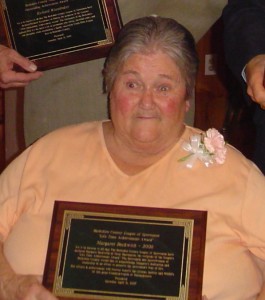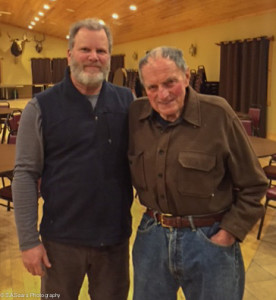On January 28, Bass Pro Shops in Hooksett, New Hampshire, hosted the first New England Turkey Hunting Hall of Fame inductions, recognizing those who played pivotal roles in bringing wild turkeys back from extinction in New England. Wild turkeys were extinct for about a century. Their return is an improbable story of long-dedicated, cooperative biologists helping each other spread the right wild stock back here. Once they figured out how to do that, wild turkeys naturally did the rest.
The New England Hall of Fame was the brainchild of two Massachusetts National Wild Turkey Federation (NWTF) chapter presidents: Keith Fritz of central Mass. and Kevin Antonovitch of Cape Cod.
These first Hall of Fame inductees came from all six New England states, and included the 10 giants of our region’s turkey conservation: Massachusetts’ James Cardoza and Jim Bolduc, New Hampshire’s Chip Page and Ted Walski, Vermont’s Doug Blodgett and Ron Lafreniere, Maine’s Jim Wescott and Gene Howard, Connecticut’s Steve Jackson and Rhode Island’s Jim Chadwick. All 10 received a decorative plaque along with a handsome, custom, curly-maple box call with their names, states and Hall of Fame credentials inscribed on the striker top. If you hunt turkeys anywhere in New England, you owe thanks to one or more of these dedicated men.
I will highlight our Massachusetts inductees. Beginning in 1969, Jim Cardoza supervised the recovery of Massachusetts’ extinct wild turkey. They originally were common everywhere in the state, except on Nantucket and Martha’s Vineyard, but as a result of deforestation and overhunting, they were extirpated by the 1850’s.
In 1972-73, Cardoza’s team live-trapped 37 wild turkeys from southwestern New York and released them in Beartown State Forest in Monterey where they flourished. In 1978, there were enough surplus birds for Cardoza to trap and release them to other areas within the state. Between 1979 and 1996, they released 561 birds in 10 counties.
As a result of Cardoza’s efforts, Massachusetts now has a population of about 25,000 wild turkeys. Thanks to their success, we have both a spring and fall hunt, which produce a perennially sustainable harvest of about 3,000. Cardoza wrote a book entitled, “The Wild Turkey in Massachusetts”, which is considered the definitive book on our wild turkeys. It explains why they originally failed in their restoration attempts and how they finally succeeded.
Jim Bolduc was honored for being the first NWTF Massachusetts state chapter president. Established in 1983, his was the first chapter established in year three of Massachusetts turkey hunting. He contacted the NWTF about starting a chapter in Massachusetts and became the first Massachusetts Chapter president. With help from his officers and board, he helped set the foundations for inspiring and educating our state’s sportsmen to support wild turkey restoration here.
Back then, less than a 100 hunters were chosen annually by lottery and restricted to hunting towns across a northwest strip of the state. The hunting territory included the northern Franklin and Berkshire County border towns where turkeys started spilling in from southern Vermont and Upstate New York. Today, his chapter is one of six in the state; the others are Eastern Mass. (1986), Central Mass. (1996), Western Mass Longbeards (1996), Pioneer Valley Longbeards (1996), and Cranberry Country Longbeards (2000). It is anticipated that a seventh chapter, the Greylock Gobblers (Northern Berkshires), will come to fruition later this year.
Back at the time of their reintroduction, wild turkeys were found in pockets of western Massachusetts but they began to spread into the central part of the state with the assistance of aggressive MassWildlife stocking initiatives. Today there are turkeys statewide.
Without pioneers like Bolduc and Cardoza, who were leaders of the successful restoration program, hunters and wildlife enthusiasts alike would not have such easy access to what has since become our state game bird.
Much of the information for this article was gleaned from MassWildlife and articles written by Mark Blazis of the Worcester Telegram (“Getting to know wild turkey hunting’s hall of famers”, February 6, 2017) and from Gary Sanderson’s article in the Greenfield Recorder (“Colrain turkey hunter inaugural New England Hall of Famer”, February 14, 2017).
Staying with the subject of wild turkeys, the Massachusetts Young Adult Turkey Hunting Program is a partnership program between MassWildlife, the Massachusetts State Chapter of the NWTF, and participating sportsmen’s clubs. The program is designed to provide hunters ages 12-17 an opportunity to: (a) Participate in a field workshop that provides specialized training in turkey hunting and safety, including firearms instruction and practice; and (b) Hunt wild turkey under the supervision and guidance of a safe, experienced adult hunter serving as a mentor on a special day set aside just for young adults.
Information on this program can be obtained from the MassWildlife web page under the caption Education & Events. The listing of local participating sportsmen’s clubs and schedules are listed there.
Incidentally, this year the Youth Turkey Hunt day is Saturday, April 22.
Events
The Lee Sportsmen’s Association is beginning its spring turkey shoots next Sunday, March 12 from noon to 3pm and they will run until the Sunday before Easter. Shoots cost $2 per shot and $3 for the money shoots. If you prefer, you could win strip steaks, pork loins or spiral hams.
The Pittsfield Sportsmen’s Club is having a venison buffet next Saturday, March 11 at the ITAM Lodge, 22 Waubeek Rd, Pittsfield. The proceeds will benefit its Land Development Fund. Cocktails start at 5pm, dinner at 6pm. There will be a 50/50 and assorted raffles. Donation are $17 for adults and children under 10 years of age $8.50. For tickets contact: Stan Bushey (413) 841-8345, Travis Delratez (413) 441-7979, Dave Pemble (413) 443-0646, Rich Powers (413) 822-6581, Fran Tremblay (413)443-5133 and Mike Furey (413) 822-1959.



![thumbnail_2017-01-24_10.31.32[1]](https://www.berkshireoutdoorsman.com/wp-content/uploads/2017/01/thumbnail_2017-01-24_10.31.321-300x214.jpg)